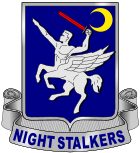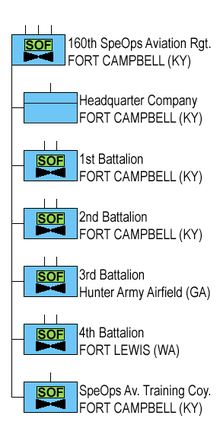160th Special Operations Aviation Regiment (Airborne)
|
160th Special Operations Aviation Regiment |
|
|---|---|
|
Emblem of the "Night Stalkers" |
|
| Lineup | October 16, 1981 |
| Country |
|
| Armed forces |
|
| Armed forces |
|
| Type | Command unit |
| Strength | ~ 1,800 |
| Insinuation |
|
| headquarters | Fort Campbell , Kentucky |
| Origin of the soldiers |
|
| Nickname | "Night Stalkers" |
| motto |
“Night Stalkers don't quit!” Night Stalkers don't give up! "Death waits in the dark" Death waits in the dark |
| Butcher |
Operation Urgent Fury Operation Just Cause |
| commander | |
| commander |
|
The 160th Special Operations Aviation Regiment ( Airborne ), short 160th SOAR , also known as Night Stalkers known is the helicopter - and drones regiment of the US Army Special Operations Command and forms with its specially modified aircraft, the air transport component of the special forces of the US armed forces.
history
Due to the unsuccessful liberation of hostages in Iran (see Operation Eagle Claw ), the US Army became aware in 1980 that it needed a special Army Aviation Regiment that was able to carry out covert transports for special commands. For this reason, the Task Force 160 unit was set up and began to exercise special flight tactics. On October 16, 1981, this unit became the 160th Special Operations Aviation Battalion , which was still known as Task Force 160 . The unit was initially formed from parts of the most famous US Army Aviation Battalion such as the 101st Aviation Battalion , the 158th Aviation Battalion , the 229th Aviation Battalion and the 159th Aviation Battalion . The specialization in night operations brought the unit later in public the nickname Night Stalkers ("nocturnal sneakers" or "nocturnal stalkers").
The unit's pilots flew missions during Operation Urgent Fury in Grenada under very poor weather conditions. The unit also proved its worth in Operation Prime Chance in the Persian Gulf and Operation Just Cause in Panama . On May 16, 1990, the battalion was expanded to a regiment and also took part in Operation Irene in Mogadishu, capital of war-torn Somalia, carried out by the Task Force Ranger , which ended in a Pyrrhic victory .
The 160th Special Operations Aviation Regiment, together with the Navy Seal Team Red Squadron of the United States Naval Special Warfare Development Group (DEVGRU), participated in the killing of Osama bin Laden during Operation Neptune's Spear on May 2, 2011.
assignment
The task of the 160th SOAR is the transport and combat and logistics support for all mission profiles of the US Special Operations Forces (SOF). Users include the Rangers , the SEALs, the Green Berets, and the Delta Force . The acronym SOAR was chosen based on the English verb “to soar”, which roughly means “to float silently” (to rise) and aptly describes the regiment's mission. The regiment consisted of around 1400 soldiers and was expanded by 900 men and 35 helicopters by 2009. The expansion was officially completed on October 28, 2009.
organization
The regiment consists of four army aviation battalions, a headquarters company and a training company and is currently led by Lieutenant Colonel Anthony Parreno.
- The 1st Battalion / 160th SOAR is stationed at Fort Campbell , the same base as the 101st Airborne Division (Air Assault) , and has 18 AH-6H / J Little Birds , 18 MH-6H / J, 20 MH-60K Black Hawks and 15 MH-60L equipped. Half of the MH-60L should be equipped in the Direct Action Penetrator (DAP) configuration. The battalion was formed in 1990 and primarily supports the units 1st Special Forces Detachment Team Delta (1st SFOD-D (A), better known as Delta Force ) and the United States Naval Special Warfare Development Group (former SEAL Team Six). This battalion was involved in the Battle of Mogadishu on October 3, 1993 , in the course of which 18 US soldiers died and pilot Mike Durant was shot down and captured.
- The E-Company of the 1st Battalion is stationed in Daegu , South Korea , where it ensures the mobility of the US special forces in Southeast Asia with its 8 MH-47 helicopters .
- The 2nd Battalion / 160th SOAR is equipped with 24 heavy-lift helicopters of the type MH-47 Chinook and was also formed in 1990. The second battalion provides long-range support for the units and is also stationed at Fort Campbell.
- The 3rd Battalion / 160th SOAR was formed in 1989 from parts of the 129th Aviation Company and is stationed at Hunter Army Airfield in Georgia . It is equipped with 20 MH-60L, half of them in the DAP configuration and 8 MH-47s. The battalion primarily supports the 75th Ranger Regiment .
- The 4th Battalion / 160th SOAR is stationed in Fort Lewis , Washington state .
- The Special Operations Aviation Training Company is stationed as a training unit of the regiment in Fort Campbell and equipped with 15 MH-6C, 3 MH-47D, 2 MH-47, 3 MH-60L and 2 MH-60K.
Recruitment and training
In order to become a pilot of the 160th SOAR , the candidate must complete a complete deployment round and complete a special course after graduating from flight school. A total of 1000 flight hours and 100 night flight hours are required. During the training at Fort Campbell, the prospective SOAR pilot has to go through various exercises and is intensively tested. The training for pilots lasts eight months, during which, among other things, flight maneuvers are practiced at a height of just six meters. In addition, pilots often attend other courses, such as the air landing school.
equipment
The flying device of the 160th SOAR (A) includes helicopters suitable for night combat, whose communication, navigation and defensive systems are regularly brought up to date with the latest technology. Operations from advanced bases and ships are thus possible.
The 160th SOAR (A) flies the MH-6J Little Bird, AH-6J Little Bird, MH-60K Black Hawk, and MH-60L Black Hawk. The transport helicopter MH-47 Chinook is available in different expansion stages. The 160th received the last 61 helicopters of the expansion stage "G" from 2004 to 2011.
Furthermore, the 160 SOAR has had twelve MQ-1C Gray Eagles since 2013, one of which crashed in Iraq in July 2015. RQ-11B Raven and RQ-7 Shadow drones are also used by the unit.
Web links
- Brief overview on the US Army Special Operations Command website ( January 10, 2015 memento in the Internet Archive )
- Brief overview on the Fort Campbell website ( Memento from April 26, 2015 in the Internet Archive )
- 160th SOAR at delta-green.com ( Memento from April 17, 2012 in the Internet Archive ) (English)
- Night Stalkers don't quit
Individual evidence
- ↑ Michael Cass: Obama thanks troops at Fort Campbell. In: Military Times. May 6, 2011, accessed May 7, 2011 .
- ↑ Sean D. Naylor: SEALs in bin Laden raid drawn from Red Squadron. (No longer available online.) In: Marine Corps Times. May 5, 2011, archived from the original on May 10, 2011 ; accessed on May 7, 2011 .
- ↑ boeing.com Boeing Delivers First MH-47G Special Operations Chinook ( memento of October 8, 2011 in the Internet Archive ), accessed on May 5, 2011.
- ↑ boeing.com PDF: US Army Special Operations Command MH-47G Special Operations Chinook ( Memento December 24, 2012 in the Internet Archive ), accessed May 5, 2011.
- ↑ US Army Special Operations MQ-1C drone has crashed in Iraq. And someone took a selfie with the wreck. In: The Aviationist. July 21, 2015, accessed July 25, 2016 .
- ↑ Legendary US Army Special Operations Force gets MQ-1C Gray Eagle drones. In: The Aviationist. Retrieved July 26, 2016 .
- ^ Michael Hoffman: Gray Eagle Company Joins 160th SOAR. December 12, 2013, accessed July 25, 2016 .




